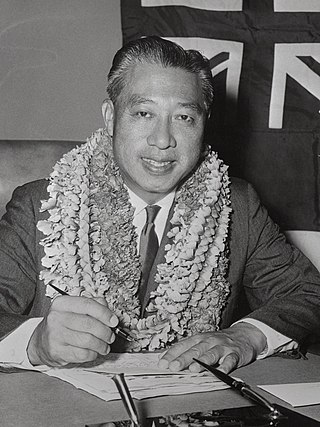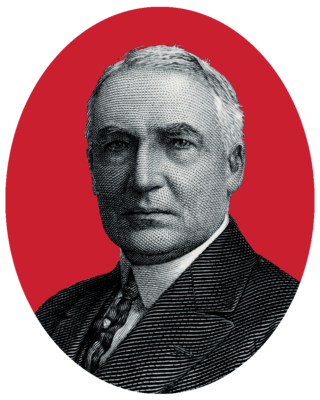
Alton Brooks Parker was an American judge. He was the Democratic nominee in the 1904 United States presidential election, losing in a landslide to incumbent Republican Theodore Roosevelt.

Hiram Leong Fong was an American businessman, lawyer, and politician from Hawaii. Born to a Cantonese immigrant sugar plantation worker, Fong was one of the first two senators for Hawaii after it became the 50th US state in 1959. He was the first Chinese-American and first Asian-American United States Senator, serving from 1959 to 1977.

The 1920 Republican National Convention nominated Ohio Senator Warren G. Harding for president and Massachusetts Governor Calvin Coolidge for vice president. The convention was held in Chicago, Illinois, at the Chicago Coliseum from June 8 to June 12, 1920, with 940 delegates. Under convention rules, a majority plus one, or at least 471 of the 940 delegates, was necessary for a nomination.

The 1924 Republican National Convention was held in Cleveland, Ohio, at the Public Auditorium, from June 10 to 12.

The 1912 Republican National Convention was held at the Chicago Coliseum, Chicago, Illinois, from June 18 to June 22, 1912. The party nominated President William Howard Taft and Vice President James S. Sherman for re-election for the 1912 United States presidential election.

Lester Jesse Dickinson was a Republican United States Representative and Senator from Iowa. He was, in the words of Time magazine, "a big, friendly, white-thatched Iowa lawyer." In early 1936, he dreamed of winning the presidency. However, the only race he would enter that year would be for his own seat in the Senate which he lost.

The 1928 New York state elections were held on November 6, 1928, to elect the governor, the lieutenant governor, the state comptroller, the attorney general, a U.S. Senator and a judge of the New York Court of Appeals, as well as all members of the New York State Assembly and the New York State Senate.

The 1926 New York state election was held on November 2, 1926, to elect the governor, the lieutenant governor, the state comptroller, the attorney general, a U.S. Senator, the chief judge and an associate judge of the New York Court of Appeals, as well as all members of the New York State Assembly and the New York State Senate. A referendum to repeal Prohibition was also proposed and accepted by a very large majority.
The following table indicates the party of elected officials in the U.S. state of New Hampshire:

Various kinds of elections in Connecticut occurs annually in each of the state's cities and towns, the exact type of which is dependent on the year. Elections for federal and statewide offices occur in even-numbered years, while municipal elections occur in odd-numbered ones. The office of the Connecticut Secretary of State oversees the election process, including voting and vote counting. In a 2020 study, Connecticut was ranked as the 20th easiest state for citizens to vote in.

Elections for state and federal offices for the 2010 election cycle in Connecticut, US, were held on Tuesday, November 2, 2010. Any necessary primary elections for the Republican and Democratic parties were held on Tuesday, August 10, 2010.

The United States Senate election of 1930 in Massachusetts was held on November 4, 1930. Incumbent Republican Senator Frederick H. Gillett did not run for re-election. In the open race to succeed him, Democratic Mayor of Fitchburg Marcus A. Coolidge defeated former U.S. Senator William M. Butler.

The 2014 United States Senate election in Alaska took place on November 4, 2014, to elect a member of the United States Senate to represent the State of Alaska, concurrently with the election of the governor of Alaska, as well as other elections to the United States Senate in other states and elections to the United States House of Representatives and various state and local elections.

The 1932 United States Senate election in Connecticut was held on November 8, 1932. Incumbent Senator Hiram Bingham III ran for a second full term in office but was defeated by Democratic U.S. Representative Augustine Lonergan. This was the first time since 1879 that Democrats won this Senate seat, and the first since 1881 that they won either seat.

The 1924 United States Senate election in Oklahoma took place on November 4, 1924. Incumbent Democratic Senator Robert Latham Owen declined to run for re-election. In a crowded Democratic primary, impeached former Governor Jack C. Walton won the party's nomination with a narrow plurality. In the general election, he faced businessman William B. Pine, the Republican nominee. Though Democratic presidential nominee John W. Davis narrowly won the state over President Calvin Coolidge, Walton's unpopularity and controversy caused Democrats to lose the seat; Pine defeated Walton in a landslide.

The 1926 United States Senate election in Colorado took place on November 2, 1926. Incumbent Republican Senator Rice W. Means ran for re-election, but he was defeated in the Republican primary by Charles W. Waterman, a prominent attorney and party leader. In the general election, Waterman faced former Governor William Ellery Sweet, the Democratic nominee. Despite the nationwide Democratic trend, as well as the landslide victory for Democrats in the gubernatorial election, Waterman ended up defeating Sweet by a thin margin. Waterman would not end up serving a full term in the Senate, and died in office on August 27, 1932.

The 1926 United States Senate election in Oklahoma took place on November 2, 1926. Incumbent Republican Senator John W. Harreld ran for re-election to a second term. After facing many challengers in a crowded Republican primary, he advanced to the general election. In the Democratic primary, Congressman Elmer Thomas beat out a similarly crowded field, which included former Governor Jack C. Walton, to win his party's nomination with a plurality. In the general election, Thomas defeated Herrald in a landslide, winning his first of four terms in the U.S. Senate.

The 2022 United States Senate election in Connecticut was held on November 8, 2022, to elect a member of the United States Senate to represent the State of Connecticut.

The 2018 Connecticut Senate election was held on November 6, 2018, concurrently with the elections for the Connecticut House of Representatives, to elect members to the Connecticut General Assembly. All 36 seats in the Connecticut Senate were up for election. The election resulted in Democrats expanding control in both chambers of the Connecticut General Assembly, ending the split control in the Senate, that had been in place since the 2016 elections. Primary elections were held on August 14, 2018.




















